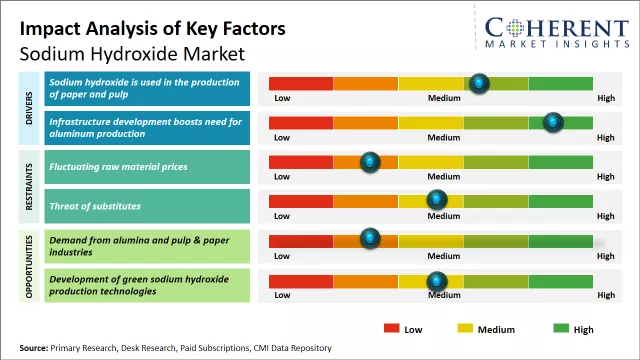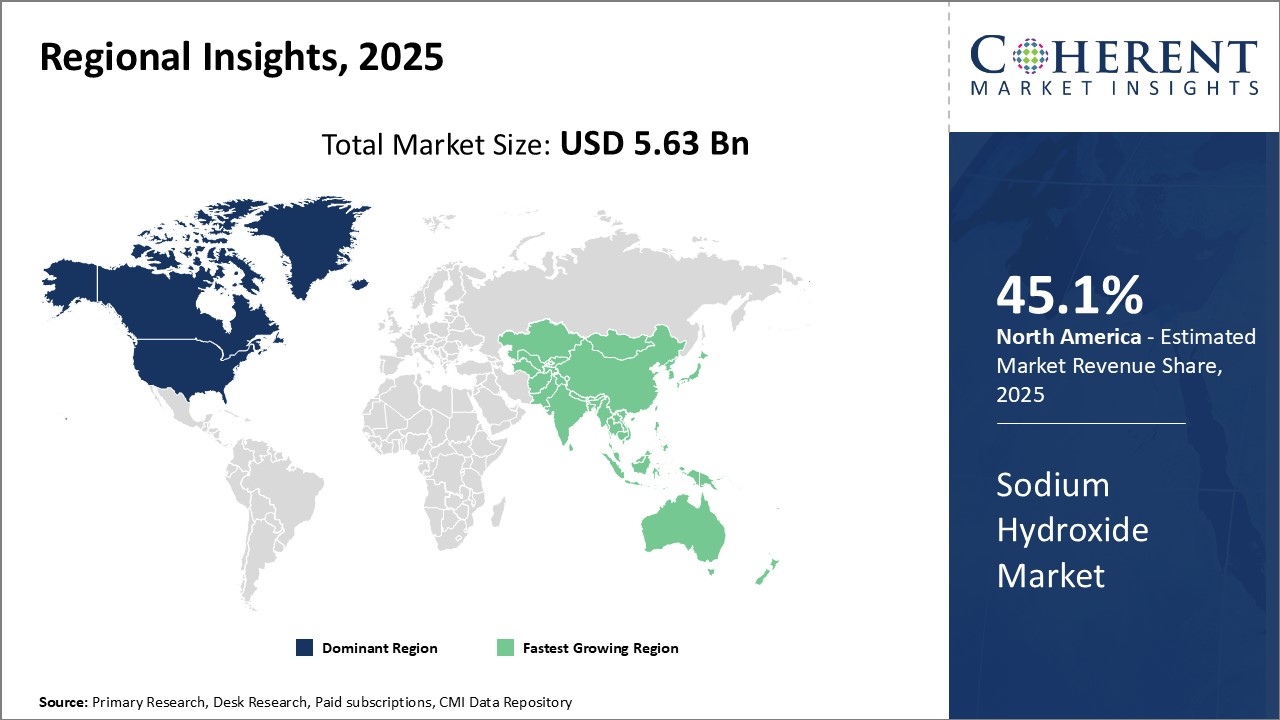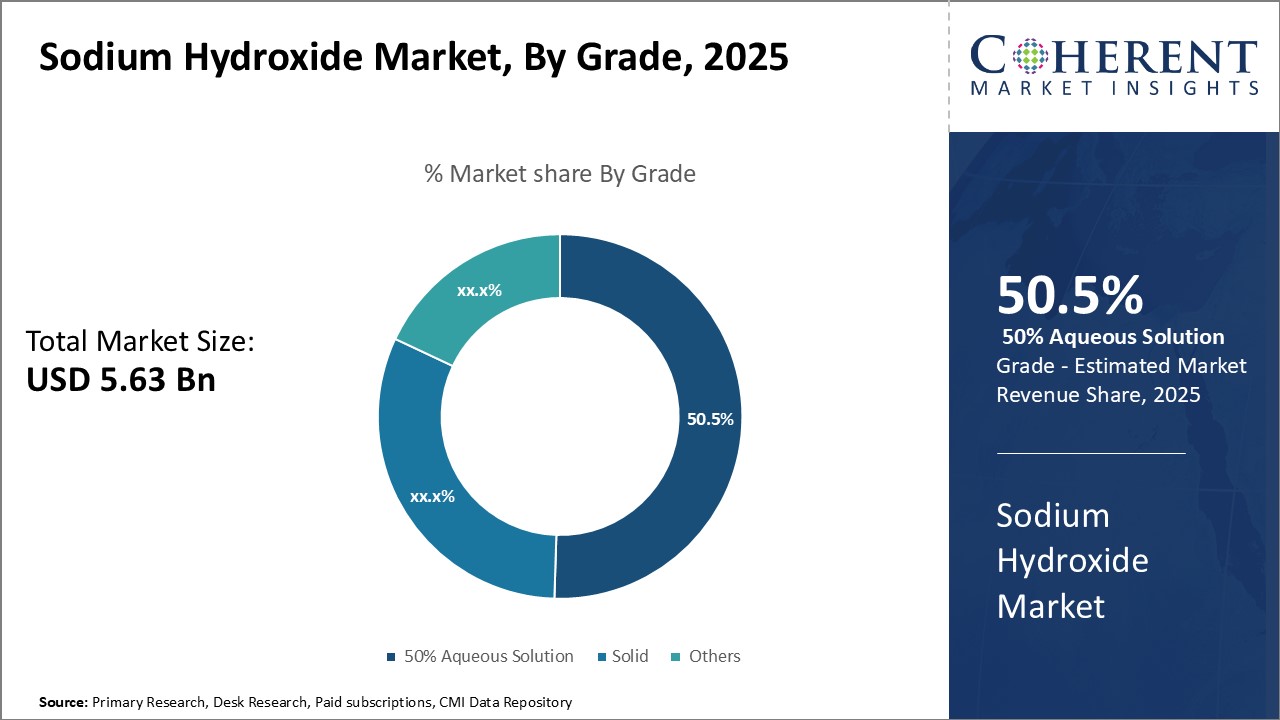Sodium Hydroxide Market Analysis & Forecast: 2025-2032
Sodium Hydroxide Market is estimated to be valued at USD 5.63 Bn in 2025 and is expected to reach USD 7.72 Bn in 2032, exhibiting a compound annual growth rate (CAGR) of 4.6% from 2025 to 2032.

To learn more about this report, Download Free Sample
Key Takeaways
- Based on Grade, the 50% Aqueous Solution Category is anticipated to account for the largest share of 67% for the Sodium Hydroxide market in 2025.
- On the basis of Production Process, the Membrane Cell Segment is anticipated to hold major share of 43.5% the Sodium Hydroxide market in 2025.
- According to Application, Inorganic Chemicals Category is expected to hold a major share of 45.5% for Sodium Hydroxide Market in 2025.
- According to region, North America also holds the largest market share with 45.1%for Sodium Hydroxide market growth by 2025.
Market Overview
The global Sodium Hydroxide Market Size fuels as it is highly hygroscopic, reacting readily with carbon dioxide in the air and requiring storage in tightly sealed containers to prevent moisture absorption. The demand is projected to increase with rapid industrialization and economic growth in various regions across the globe. The market is expected to witness fruitful opportunities and maintain a steady growth trend during the forecast period. Rising demand from end-use industries like paper & pulp and alumina along with growth in other industries will drive the sodium hydroxide market growth during this period.
Current Events and Its Impact on the Sodium Hydroxide Market
|
Event |
Description and Impact |
|
High Energy Costs and Reduced Availability in Europe |
|
|
Technological Advancements in Production Processes |
|
Uncover macros and micros vetted on 75+ parameters: Get instant access to report
Pricing Analysis
- The global sodium hydroxide (NaOH) market, also known as caustic soda, plays a crucial role in industrial sectors such as pulp and paper, textiles, alumina extraction, soaps and detergents, and petrochemicals. As of early 2025, prices have shown a downward trend in most regions due to a combination of weak downstream demand and oversupply.
- In North America, average prices range between $450 and $520 per metric ton, reflecting a 5–7% decline from Q4 2024. Similarly, in Europe, prices have dropped by nearly 8–10%, averaging €480 to €540 per metric ton, largely due to elevated energy costs and reduced industrial output. China, a major producer and consumer, is experiencing a sharper decline of about 10–12%, with prices ranging between ¥2,600 and ¥2,900 per metric ton due to tepid domestic demand and weak export orders.
- In contrast, the Indian market has remained relatively stable, with prices holding between INR 35,000 and INR 39,000 per metric ton, supported by consistent demand from the textile and alumina sectors.
Sodium Hydroxide Market Insights, by Grade
In terms of grade, 50.5% aqueous solution contributes the 67% share of the market owing to its significant production advantages over solid sodium hydroxide. Producing 50% aqueous solution skips the pelletizing or granulation process required for solid sodium hydroxide, allowing manufacturers to achieve higher production volumes in the same plant infrastructure. It also eliminates the energy costs associated with drying and eliminates risks of dust explosion that can occur during powder handling of solid grades.
Sodium Hydroxide Market Insights, by Production Process
In terms of production process, membrane cell contributes the 43.5% of the market share owing to its significantly higher resource efficiency compared to alternatives like diaphragm cell. Membrane cell technology enables maximizing the concentration of sodium hydroxide in an energy efficient manner using selective ion permeable membranes instead of diaphragms. This allows operating at high current densities while maintaining high electrical efficiency. It eliminates cross-contamination between anolyte and catholyte streams, reducing chemical consumption and waste generation.
Sodium Hydroxide Market Insights, by Application
In terms of application, inorganic chemicals contribute 45.5% of the market share owing to sodium hydroxide being extensively used as a key precursor chemical in several lucrative industrial processes. It is a basic raw material for production of sodium carbonate, zeolites, water glass, caustic potash, etc. which are then used to manufacture other in-demand chemicals. Due to its commoditized nature and need in high volumes, inorganic chemical producers are highly cost-sensitive.
Regional Insights

To learn more about this report, Download Free Sample
North America Sodium Hydroxide Market
North America has established itself as the dominant region in the global sodium hydroxide market with 45.1% of the market share primarily due to the robust presence of key end-use industries such as alumina, pulp and paper, soaps and detergents. The U.S. is the single largest consumer as well as producer of sodium hydroxide globally driving the demand from this region. Major industrial hubs in countries like the U.S. and Canada have significantly aided in the establishment of supply chain network within North America.
Asia Pacific Sodium Hydroxide Market
The Asia Pacific region is witnessing the fastest growth in the sodium hydroxide market over the recent past. Key factors such as rapid industrialization, growing population, and urbanization have supported the growth of industries that utilize sodium hydroxide. Particularly, the pulp and paper industry are witnessing surge in production volumes across developing economies of China, India, and Indonesia etc. Furthermore, the huge consumption from the alumina and soap and detergent industries has propelled the import volumes to fulfill the supply demand gap.
Sodium Hydroxide Market Dominating Countries
U.S Sodium Hydroxide Market
The United States is a dominant force in the global sodium hydroxide market, is supported by a strong industrial base in chemicals, pulp and paper, water treatment, and alumina production. The country benefits from advanced manufacturing technologies, a well-established supply chain, and continuous innovation, making it a key exporter and trendsetter in the sodium hydroxide industry.
India Sodium Hydroxide Market
India’s sodium hydroxide market is expanding rapidly due to robust growth in sectors such as textiles, paper, soaps, and detergents, as well as increasing infrastructure development and urbanization. The country’s industrialization and rising demand for processed goods are fueling domestic consumption, while government initiatives to boost manufacturing and improve water treatment infrastructure are further strengthening market prospects.
Market Report Scope
Sodium Hydroxide Market Report Coverage
| Report Coverage | Details | ||
|---|---|---|---|
| Base Year: | 2024 | Market Size in 2025: | USD 5.63 Bn |
| Historical Data for: | 2020 To 2024 | Forecast Period: | 2025 To 2032 |
| Forecast Period 2025 to 2032 CAGR: | 4.6% | 2032 Value Projection: | USD 7.72 Bn |
| Geographies covered: |
|
||
| Segments covered: |
|
||
| Companies covered: |
Dow, DuPont,, Sanmar Group, Gujarat Alkalies and Chemicals Limited, Bayer AG, GACL Ltd., Aditya Birla Chemicals, BSC Chemicals, Tokuyama Corporation., Covestro, BASF, Olin Corporation, Westlake Corporation, Occidental Petroleum Corporation, Xinjiang Zhongtai Chemical Co. Ltd, Akzo Nobel N.V, Brenntag North America, Inc, Vizag chemical, Astrra Chemicals, Vinayak Chemicals, and Ottokemi |
||
| Growth Drivers: |
|
||
| Restraints & Challenges: |
|
||
Uncover macros and micros vetted on 75+ parameters: Get instant access to report
Market Concentration and Competitive Landscape

To learn more about this report, Download Free Sample
Sodium Hydroxide Market: Growth Drivers
- Sodium hydroxide is used in the production of paper and pulp
One of the major drivers propelling the growth of the sodium hydroxide market is the rise in paper production across the globe. For instance, according to data published by the Vietnam Pulp and Paper Association (VPPA) in 2021, the consumption of paper for packaging in Vietnam in May 2021 was 404,711 metric tons, an all-time high. The domestic paper industry has witnessed positive growth over the last five years (2015–2020), and it is expected to grow continuously over the forecast period.
Thus, increasing paper production to meet the growing demand from the packaging sector and capacity expansion of paper production mills are expected to drive demand over the forecast period. Sodium hydroxide, commonly known as caustic soda, is one of the key ingredients used in the manufacturing process of paper. It acts as a bleaching agent that removes remaining lignin from the pulp to give paper its characteristic whiteness.
- Infrastructure development boosts need for aluminum production
Accelerating the sodium hydroxide market is the aluminum industry. Sodium hydroxide acts as an essential feedstock material that is used widely in the electrolytic production of primary aluminum. It enhances the conductivity of alumina and allows the metal to be readily dissolved out of the smelting pot. With infrastructure development activities picking up pace globally, fueled by post-pandemic economic recovery programs of various nations, the aluminum demand is surging significantly.
Sodium Hydroxide Market: Trends
Industrial Demand Expansion
Growth is fueled by the pulp and paper sector, chemical manufacturing, soap and detergent production, water treatment, and applications in petroleum and metal processing.
Sodium Hydroxide Market: Opportunities
Demand from alumina and pulp & paper industries
The demand from alumina and pulp & paper industries is expected to grow steadily. Sodium hydroxide finds applications in chemical processing, so expansion in end-use sectors will boost consumption. Adoption of membrane cell technology enables efficiency gains and lowers energy usage in manufacturing. Collaboration with regulatory bodies can help address transportation issues while maintaining safety.
Sodium Hydroxide Market: Key Developments
- April 2025, DCM Shriram commissioned a new 300 TPD caustic soda flakes plant at its Jhagadia facility in Gujarat, increasing the total capacity at the site to 900 TPD. This makes it one of India's largest single-location producers of caustic soda flakes.
- November 2024, TMK Chemical Bhd, set to list on Bursa Malaysia's Main Market in December, plans to double its annual manufacturing capacity, with its second plant funded by the initial public offering (IPO) proceeds. TMK Chemical, specialising in chemical management and storage solutions, aims to double its existing capacity of 216,000 metric tons (MT) to a maximum of 432,000 MT of sodium hydroxide at a concentration of 32%, with the new Banting Plant 2, according to deputy general manager Leong Xiao Lung.
- November 2024, ANSA McAL Ltd announced the acquisition of US-based chlor-alkali producer BleachTech via its US subsidiary ANSA Chemicals US, for $327 million, which represents the largest acquisition in the Caribbean conglomerate’s 143-year history. BleachTech, based in Cleveland, OH, operates two chlor-alkali plants in Seville, OH and Petersburg, VA that produce sodium hypochlorite (bleach), sodium hydroxide (caustic soda) and hydrochloric acid.
Analyst Opinion
- The Sodium Hydroxide market is expected to witness steady growth in the coming years due to increasing demand from the paper and pulp industry. Asia Pacific dominates global consumption due to presence of large paper industry in China and India. North America and Europe are also sizable markets driven by chemical processing applications.
- Demand from alumina production is a key driver for the market as sodium hydroxide is integral to bayer process. Recovery in construction sector would further aid market expansion through increased steel and alumium demand. Growth in textiles may also support market growth over forecast period.
- Market players could face challenges from fluctuating raw materail prices. Availability and pricing of salt which is key raw material can impact sodium hydroxide prices. Stringent environmental regulations around and use could constrain market to some extent.
Sodium Hydroxide Market: Key Companies
Some of the key players in the global Sodium Hydroxide market are Dow, DuPont,, Sanmar Group, Gujarat Alkalies and Chemicals Limited, Bayer AG, GACL Ltd., Aditya Birla Chemicals, BSC Chemicals, Tokuyama Corporation., Covestro, BASF, Olin Corporation, Westlake Corporation, Occidental Petroleum Corporation, Xinjiang Zhongtai Chemical Co. Ltd, Akzo Nobel N.V, Brenntag North America, Inc, Vizag chemical, Astrra Chemicals, Vinayak Chemicals, and Ottokemi.
Market Segmentation
- By Grade
- Solid
- 50% Aqueous Solution
- Others
- By Production Process
- Membrane Cell
- Diaphragm Cell
- Others
- By Application
- Biodiesel
- Alumina
- Inorganic Chemicals
- Organic Chemicals
- Food
- Pulp & Paper
- Soap & Detergent
- Textiles
- Others (Water Treatment, etc.)
- By Regional
- North America
- U.S.
- Canada
- Latin America
- Brazil
- Argentina
- Mexico
- Rest of Latin America
- Europe
- Germany
- U.K.
- Spain
- France
- Italy
- Russia
- Rest of Europe
- Asia Pacific
- China
- India
- Japan
- Australia
- South Korea
- ASEAN
- Rest of Asia Pacific
- Middle East
- GCC Countries
- Israel
- Rest of Middle East
- Africa
- South Africa
- North Africa
- Central Africa
- North America
- Company Profiles
- Dow
- DuPont,
- Sanmar Group
- Gujarat Alkalies and Chemicals Limited
- Bayer AG, GACL Ltd.
- Aditya Birla Chemicals
- BSC Chemicals
- Tokuyama Corporation.
- Covestro
- BASF
- Olin Corporation
- Westlake Corporation
- Occidental Petroleum Corporation
- Xinjiang Zhongtai Chemical Co. Ltd
- Akzo Nobel N.V
- Brenntag North America, Inc
- Vizag chemical
- Astrra Chemicals
- Vinayak Chemicals
- Ottokemi
Sources
Primary Research interviews
- Plant managers at chemical manufacturing companies (e.g., Olin Corporation, Westlake Chemical)
- Procurement officers at pulp & paper, textile, and water treatment companies
- Distributors and traders of industrial chemicals
- Environmental compliance officers (handling caustic soda usage/safety)
- Technical experts or product development heads at detergent & alumina refineries
Databases
- UN Comtrade
- ICIS Chemical Business
- U.S. Geological Survey (USGS)
- Indian Chemical Council Statistics Portal
- US International Trade Commission (USITC)
Magazines
- Chemical & Engineering News (C&EN)
- ICIS Chemical Business
- The Chemical Engineer (TCE)
- BIC Magazine
- Speciality Chemicals Magazine
- Chemical Week
Journals
- Journal of Industrial and Engineering Chemistry
- Chemical Engineering Journal
- Journal of Hazardous Materials
- Journal of Cleaner Production
- Industrial & Engineering Chemistry Research
- Environmental Science & Technology
Newspapers
- The Wall Street Journal
- The Financial Times
- Business Standard (India)
- Nikkei Asia
- Bloomberg
- Reuters
- Mint
- Economic Times
Associations
- American Chemistry Council (ACC)
- Euro Chlor (a sector group of Cefic)
- Chlorine Institute
- Indian Chemical Council (ICC)
- China Chlor-Alkali Industry Association
- Japan Soda Industry Association
- Association of Petrochemicals Producers in Europe (APPE)
- Gulf Petrochemicals and Chemicals Association (GPCA)
Proprietary Elements:
- CMI Data Analytics Tool, Proprietary CMI Existing Repository of information for last 8 years
*Definition: Sodium hydroxide, also known as lye or caustic soda, is an inorganic compound with the chemical formula NaOH. It is a white, odorless, highly corrosive solid that consists of sodium cations (Na⁺) and hydroxide anions (OH⁻). It is highly soluble in water, releasing a large amount of heat upon dissolution, and forms strongly alkaline solutions with a typical pH around 13. Sodium hydroxide is widely used industrially in the manufacture of paper, textiles, soaps, detergents, water treatment, chemical processing, and as a drain cleane.
Share
Share
About Author
Vidyesh Swar is a seasoned Consultant with a diverse background in market research and business consulting. With over 6 years of experience, Vidyesh has established a strong reputation for his proficiency in market estimations, supplier landscape analysis, and market share assessments for tailored research solution. Using his deep industry knowledge and analytical skills, he provides valuable insights and strategic recommendations, enabling clients to make informed decisions and navigate complex business landscapes.
Missing comfort of reading report in your local language? Find your preferred language :
Transform your Strategy with Exclusive Trending Reports :
Frequently Asked Questions
EXISTING CLIENTELE
Joining thousands of companies around the world committed to making the Excellent Business Solutions.
View All Our Clients

